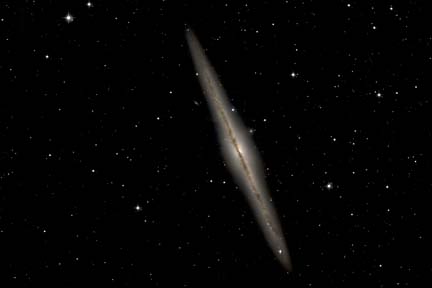
COURTESY OF DONALD HALL
This is an infrared image of the galaxy NGC 891 in the constellation Andromeda, about 10 million light-years from Earth.
Hilo telescope sees
‘big picture’ in skies
The University of Hawaii's 88-inch telescope has become the most powerful in the world for infrared imaging with the addition of a new infrared camera that increases sky coverage 16 times, according to the Institute for Astronomy.
The 16-megapixel infrared camera -- considered gigantic in terms of silicon chips -- "is an incredible step," said Donald Hall, who headed a team at the institute's Hilo facility that developed the technology with the Rockwell Scientific Co. in Camarillo, Calif.
"When I began my career many decades ago," he said, "we had only single detectors, and we had to scan them around the sky one at a time, gradually building up a picture one dot at a time."
Along with a 16-fold increase in sky coverage, the new camera has much higher sensitivity than the 1-megapixel cameras in use on telescopes for the past 10 years, he said.
Hall, the astronomy institute's former director, said as soon as big telescope projects realized the 16-megapixel technology was feasible, they began scrambling to get orders to Rockwell.
The Canada-France-Hawaii Telescope and the Frederick C. Gillett (Gemini North) Telescope on Mauna Kea are beginning to receive the first test detectors for the new cameras. They are probably a year or two behind the UH telescope, Hall said.
"At least for a year or two, that ancient telescope is back at the forefront of infrared astronomy," Hall said. "This is really important for Hawaii and especially for Hilo to be in high tech in a big way."
NASA has selected the UH/Rockwell detector technology for the camera on the next space telescope, Hall said.
Hall's team in Hilo was awarded nearly $7 million in 1999 by the NASA Ames Research Center to work with Rockwell four years on the technology.
They developed 4-megapixel chips using new infrared detector materials and state-of-the-art silicon chips which, he said, are some of the largest ever produced at nearly 2 inches by 2 inches.
Working with GL Scientific, a small Honolulu business, the team mounted the individual 4-megapixel chips so they could be "tiled" into a 16-megapixel camera -- an innovative technique that will allow for larger "mosaic" cameras in the future, Hall said.
"In addition, we have established in Hilo a facility to test these new detectors that is widely regarded as the best available," he said.
The first image by the improved telescope was of the galaxy NGC 891 in the constellation Andromeda, about 10 million light-years from Earth.
"The galaxy is just like our own Milky Way but by coincidence is seen almost exactly edge-on," Hall said.
Astronomers Richard Wainscoat and Peter Capak, a graduate student, are analyzing the image for properties of dust and star formation in the galaxy.
"With smaller cameras, galaxies such as NGC 891 had to be imaged in small postage stamp sized pieces that had to be painstakingly pieced together," Wainscoat said. "The new camera produces a better image in a tiny fraction of the time.
"By allowing us to image very large areas of the sky, this camera will allow us to detect some of the most distant galaxies in the universe."
